
Contents





A Poet Who Sings Love






Daegu’s Modern Charms
A City Worth Walking Around in
With Korea’s rapid growth over the past few decades and the concentration of resources in metropolitan areas, regional colors have grown less distinctive. Daegu is one exception. Instead of being influenced by Seoul-oriented trends, it has maintained its unique culture and history. Also known as Korea’s Vienna, the city is home to the highest number of franchise cafes in Korea. You can experience its rich culture and try an assortment of local brands in a day trip or over a night’s stay. On the KTX, Daegu is only a two-hour ride away from Seoul, and it is less than an hour by plane from Gimpo—cheaper than taking the train.
Written by Jang Hee-joo Photographed by Studio Kenn
Illustrated by Hagogo
The ARC
Where Art Meets Architecture
The ARC is a unique building that stands tall at a point where two rivers meet. The curved lines seem to be elegantly wrapped around the surrounding space. Built with the river, water and nature as motifs, the silver exterior against the blue sky creates an alluring ambiance. The interior is simple yet modern, and this design concept comes through in every detail, from the basement to the rooftop.
The exhibition in the basement is themed on history and arts that are related to rivers. You can take a seat on one of the many comfortable sofas, and ponder the meaning behind the works. The 360-degree screen installed on the ground floor shows videos on the circle of life. You can watch different episodes, and they are worth sticking around for. On the rooftop, you will find a café and an observatory, which gives a wonderful view of the two rivers and mountains further in the distance. You will be surrounded by the laughter of people having a good time while cycling or kick-boarding in the park. At dusk, the beautifully lit building becomes even more mesmerizing.
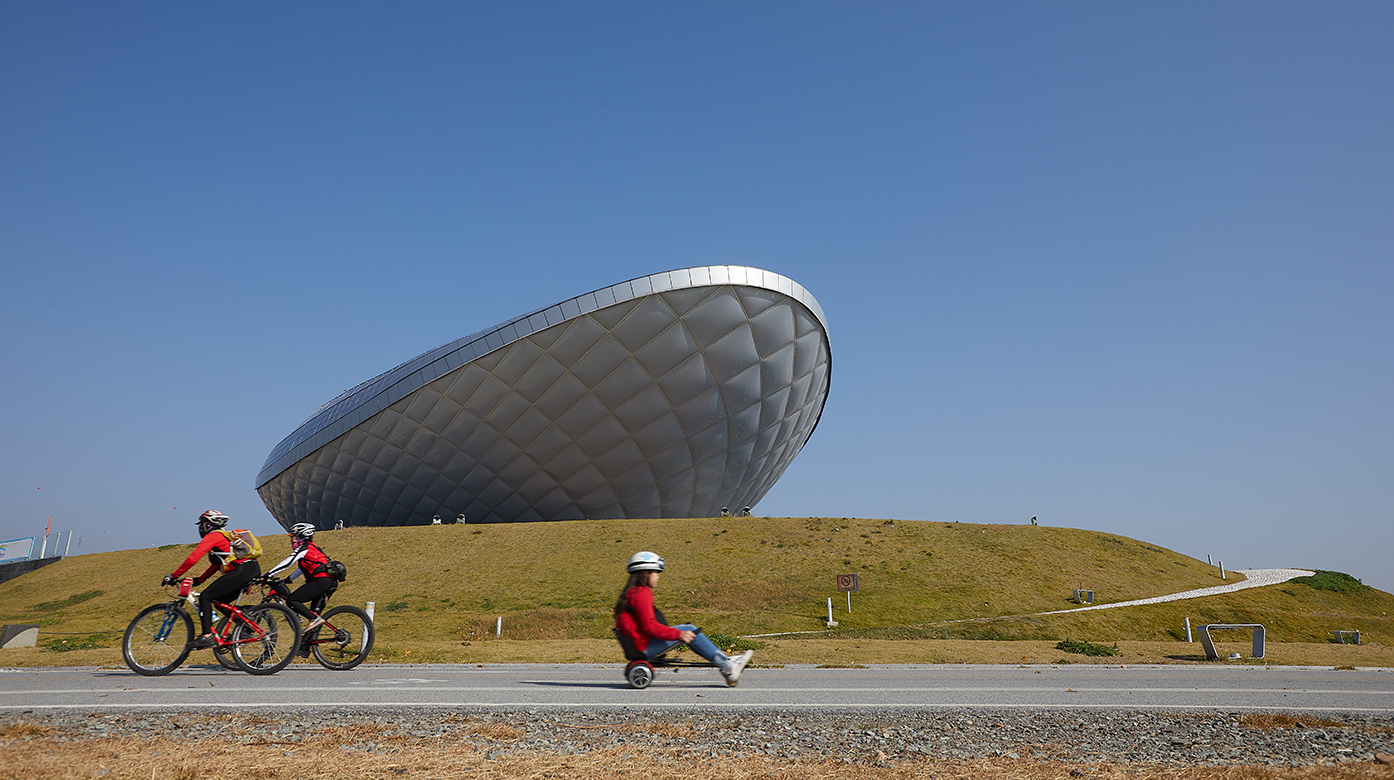 Bike-way where you can see Dalseong Marsh is in a good condition.
Bike-way where you can see Dalseong Marsh is in a good condition.3.1 Independence Movement Road
90 Stairs Dedicated to Independence
The number “3.1” in the name of the road is an unforgettable date for Koreans. On March 1, 1919, chants of “Hurray, Korean independence!” rang throughout Korea. It was the first large-scale independence movement that took place in a country under Japanese colonial rule since World War I.
The 90 stairs in the 3.1 Independence Movement Road used to be a pine grove road, which students took to avoid getting caught by the Japanese while heading to their meeting point (today’s Seomun Market). It is not a fancy tourist attraction, but the road is a witness to the history of Korea. On the sides of the road, you will find photographs of the movement, taken way back in the early 1900s.
The historic stairs lead to popular attractions such as the Gyesan Catholic Church, the first Presbyterian church of Daegu, and the House of Missionary Chamness, which has been converted into a museum. The road holds a special place in the hearts of locals, and it will be a fascinating walk down memory lane for visitors.
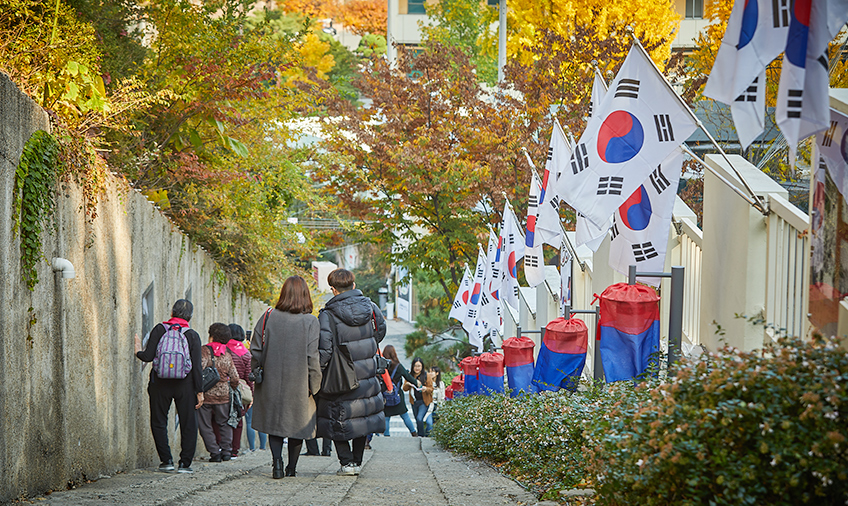 The national flag of Korea blows in the wind, and tourists look around the photos from old times along the 3.1 Independence Movement Road.
The national flag of Korea blows in the wind, and tourists look around the photos from old times along the 3.1 Independence Movement Road.Mt. Apsan Observatory
The Best Scenic View of the City
“Apsan” literally means “a mountain in front.” True to its name, the Mt. Apsan Observatory is a place where you can enjoy a panoramic view of the city. For a more unforgettable experience, you can time your visit around sunrise or sunset. At night, when the city becomes adorned with lights, this spot is popular among photographers. To get to the observatory, you can take a 15-minute cable car ride, or hike up for an hour or so. The latter choice will allow you to immerse yourself in the beauty of autumn.
Similar to Seoul’s Namsan Tower, the observatory has a railing covered with locks of love. If you’re visiting with a loved one, you will want to hang your own padlock as a symbol of immortal love. While you’re there, a good place to drop by is Apsan Park. It is the largest urban eco-park in Daegu, and offers a range of walking paths to choose from.
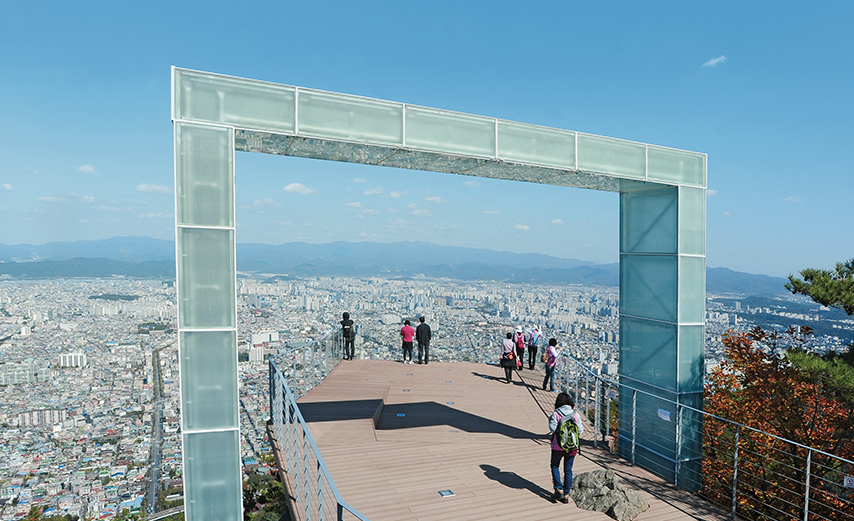 Mt. Apsan Observatory offers a view of the whole city. © Daegu Tourism Bureau
Mt. Apsan Observatory offers a view of the whole city. © Daegu Tourism Bureau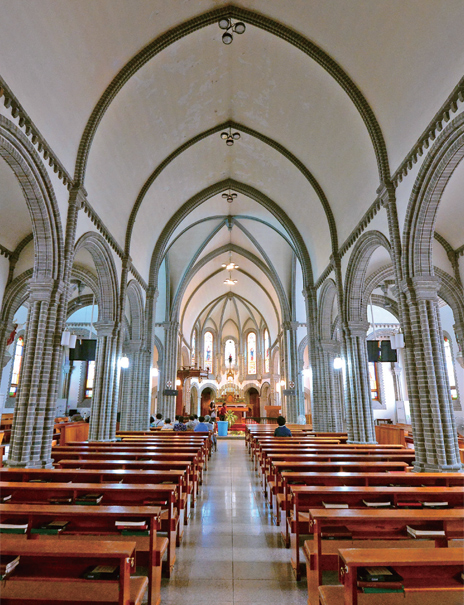 The inside view of the Gyesan Catholic Church, the first Presbyterian church of Daegu. © Daegu Tourism Bureau
The inside view of the Gyesan Catholic Church, the first Presbyterian church of Daegu. © Daegu Tourism BureauTrip Points
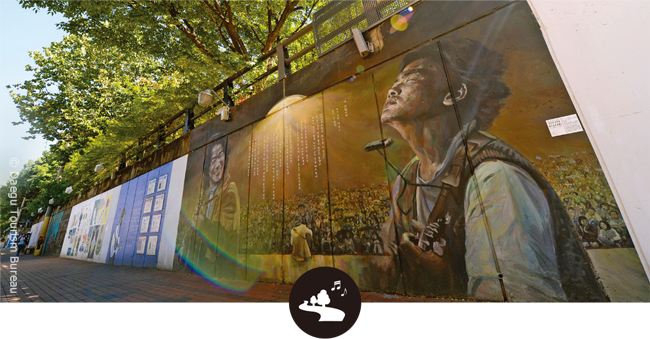
Kim Gwangseok-gil Street
Rising Back in Popularity
The late Kim Gwang-seok is still one of the most beloved singers in Korea. His hits are sung today by many people, both young and old. Next to Bangcheon Market, where he used to live, is a mural street themed on Kim Gwang-seok’s life and songs. The murals feature his lyrics, and his songs are being played over speakers. On Kim Gwangseok-gil street, you cannot help but sing along while paying tribute to the legendary singer.
Until 2010, the market was quite deserted. It was once the most popular in Daegu, but stores closed down one by one following the opening of supermarkets and department stores. The merchants worked together with artists to create the murals, and the vacant stores were rented to artists at affordable prices. This gave birth to a unique market that fuses culture and the arts. The old songs have bounced back in popularity, and patrons are returning once more to the street. You will discover a new charm with each step you take.
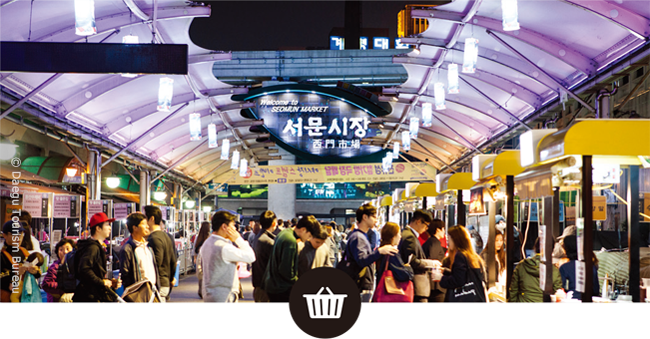
Seomun Market
The Ultimate Food Haven
Seomun Market was one of the three major markets in the late Joseon era. Today, it maintains its reputation as a traditional market, specializing in textiles and food. Known as a food haven, the market’s signature dishes attract visitors from all over the country. One of the most popular is kaljebi, which is a combination of kalguksu noodle soup and sujebi hand-pulled dough soup. The tasty yet affordable dish has many standing in a long queue at lunch time. Another specialty is samgyeopsal jjajangmyeon, which is a dish of black bean noodles topped with grilled pork belly.
The yellow-colored stalls that open at night are designed with the monorail as a motif. In the winter months of December to February, the night market stays open until 23:30 on weekdays, and 24:00 on weekends. Samgyeopsal gimbap, or seaweed rice rolls with grilled pork belly, will leave you craving more. Besides the variety of food and drinks, you can also buy unique items that evoke nostalgia.
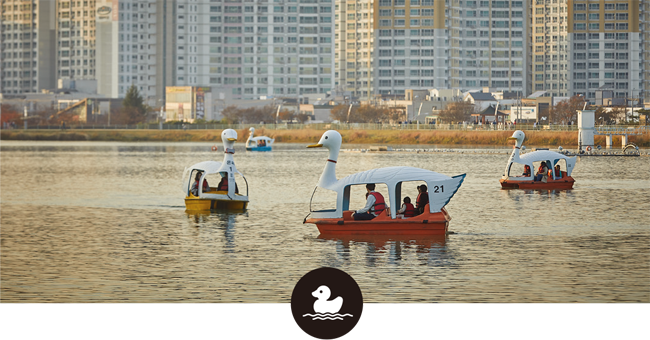
Suseongmot Lake
A Favorite Resting Place of Locals
The view at the lake is beautiful regardless of the season, but fall is undoubtedly the best time to visit. You will be greeted by foliage and reeds swaying in the wind. While taking a leisurely stroll, you can even spot wild animals every now and then. When the weather is good, there will be a fleet of duck boats cruising on the lake.
At night, the lake takes on a different mood. The boats and walking trails light up, adding to the mystical atmosphere. A fountain show runs from May to October, but stops temporarily during cold weather. If the walk has left you feeling hungry, you can drop by any of the nearby cafés or restaurants. With every place highly rated by locals, it is hard to make a wrong choice. Don’t forget your wallet if you want to pick up some great food on the way.
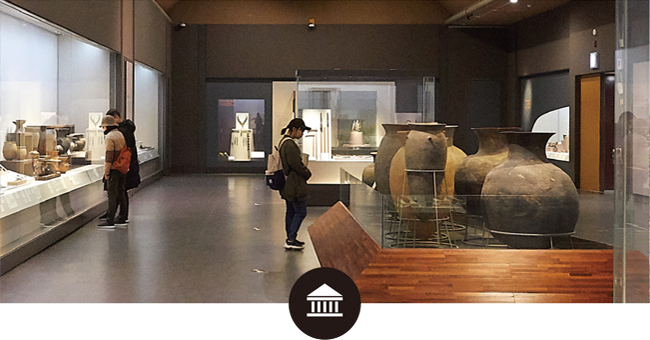
Daegu National Museum
A Walk With Your Family
The Daegu National Museum, small but satisfying, houses artifacts of Daegu and North Gyeongsang Province. It is some distance away from Dongdaegu Station, so you might have to skip it if you’re on a tight schedule. Praised by many as the perfect spot for a family outing, the museum is highly recommended especially if you’re with young children. The learning center next to the main exhibition hall provides the opportunity to draw your own picture and play traditional games. Also, the auditorium screens family movies in the afternoon every weekend.
The three regular exhibition halls are the Ancient Culture Hall, Medieval Culture Hall, and the Textiles & Clothing Hall. They feature various artifacts dating from the prehistoric ages to the Joseon era. A must-see at the museum is the giltbronze crown, influenced by Goguryeo (northern part of the Korean peninsula from 37 BCE to 668 CE) and thus rarely excavated in the south. If you’re there, drop by the library, and take a walk in the small outdoor park.
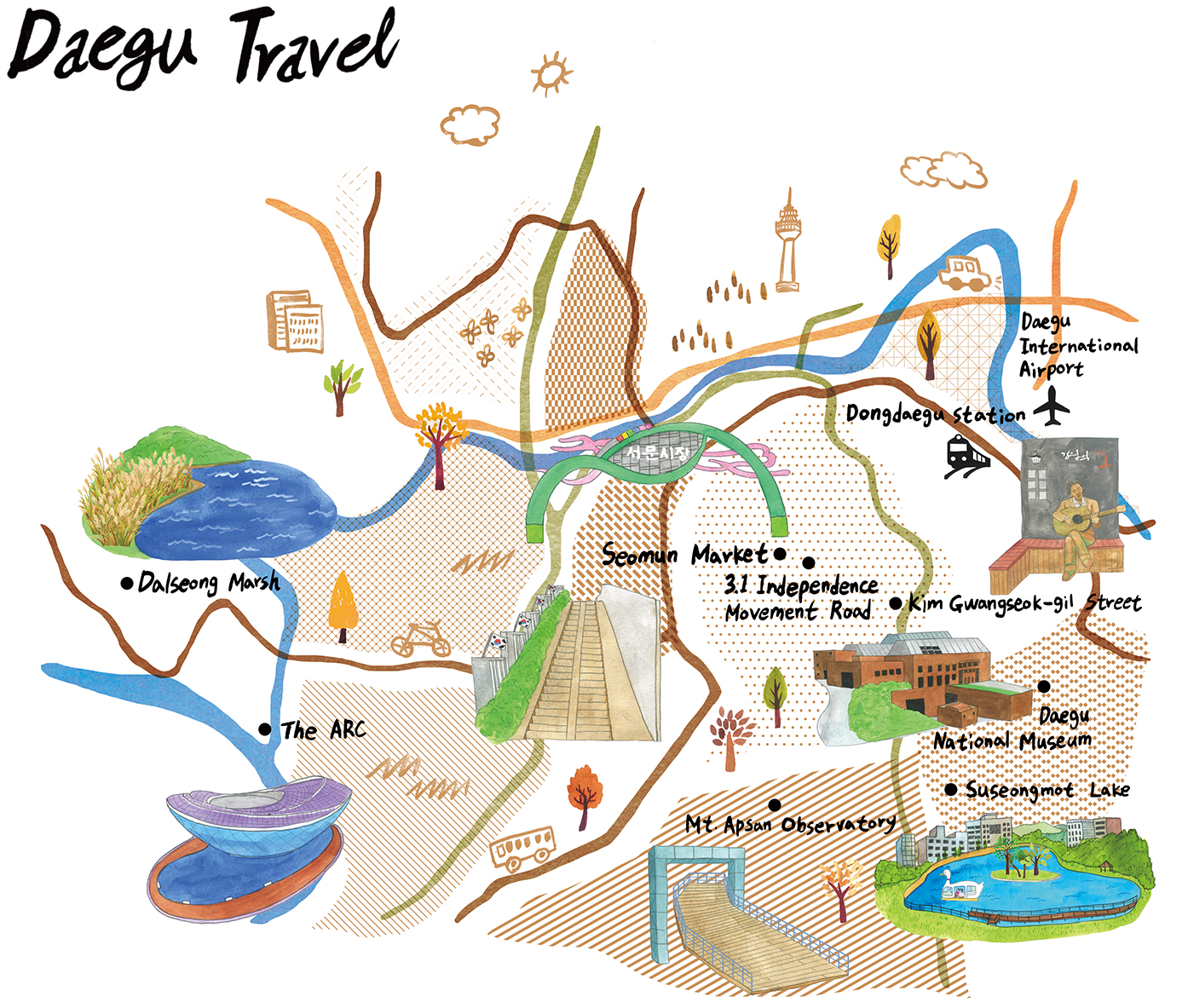
Travel Tip
-
Korea Travel Hotline
- Tel : +82-1330
Daegu Tourism Information Desk
- Address : 46, Gongwonsunhwan-ro, Dalseo-gu, Daegu
- Tel : +82-53-627-8906
- Hours : 09:00-18:00
Daegu Airport Tourism Information Desk
- Address : 221, Gonghang-ro, Dong-gu, Daegu
- Tel : +82-53-984-1994
- Hours : 09:00-19:00 -
Kim Gwangseok-gil Street
- Address : 2238, Dalgubeol-daero, Jung-gu, Daegu
- Tel : +82-70-811-3024Dongdaegu Station Tourism Information Desk
- Address : 550, Dongdaegu-ro, Dong-gu, Daegu
- Tel : +82-53-627-8900
- Hours : 09:00-18:00The ARC
- Address : 57, Gangjeongbon-gil, Dasa-eup, Dalseong-gun, Daegu
- Tel : +82-53-585-0916
- Hours : 10:00-18:003.1 Independence Movement Road
Address : 50, Gukchaebosang-ro 102-gil, Jung-gu, Daegu
- Tel : +82-53-661-2623 -
Seomun Market / Seumun Night Market
- Address : 10, Keunjang-ro 28-gil, Jung-gu, Daegu, Korea
- Hours : 05:00-24:00Daegu National Museum
- Address : 321, Cheongho-ro, Suseong-gu, Daegu
- Tel : +82-53-768-6051
- Hours : 10:00-18:00Mt. Apsan Observatory
- Address : 454 Apsansunhwan-ro, Nam-gu, Daegu
- Tel : +82-53-803-5450Suseongmot Lake
- Address : 35-5, Yonghak-ro, Suseong-gu, Daegu
- Tel : +82-53-666-2863
Other Articles





A Poet Who Sings Love





Application of subscription
Sign upReaders’ Comments
GoThe event winners
Go


 December 2018
December 2018


